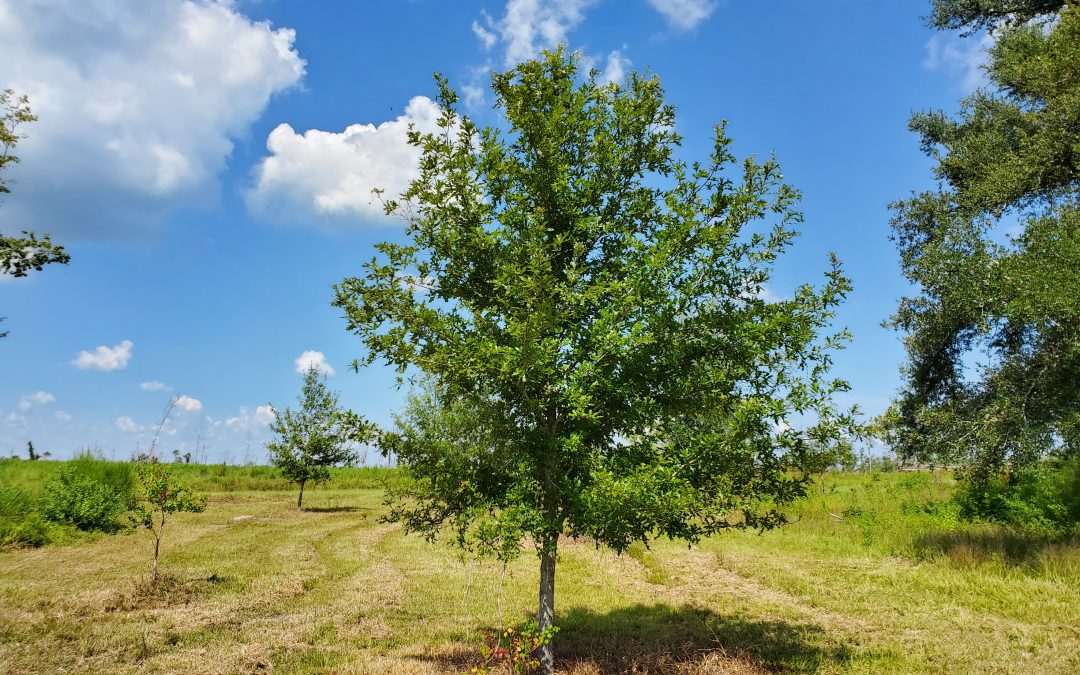
by Daniel J. Leonard | Sep 3, 2020
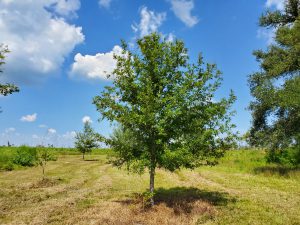
Overcup on the edge of a wet weather pond in Calhoun County. Photo courtesy of Daniel Leonard.
Haunting alluvial river bottoms and creek beds across the Deep South, is a highly unusual oak species, Overcup Oak (Quercus lyrata). Unlike nearly any other oak, and most sane people, Overcups occur deep in alluvial swamps and spend most of their lives with their feet wet. Though the species hides out along water’s edge in secluded swamps, it has nevertheless been discovered by the horticultural industry and is becoming one of the favorite species of landscape designers and nurserymen around the South. The reasons for Overcup’s rise are numerous, let’s dive into them.
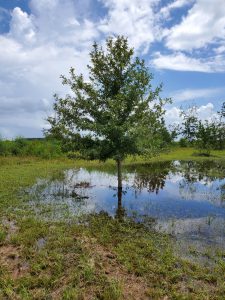
The same Overcup Oak thriving under inundation conditions 2 weeks after a heavy rain. Photo courtesy Daniel Leonard.
First, much of the deep South, especially in the Coastal Plain, is dominated by poorly drained flatwoods soils cut through by river systems and dotted with cypress and blackgum ponds. These conditions call for landscape plants that can handle hot, humid air, excess rainfall, and even periodic inundation (standing water). It stands to reason our best tree options for these areas, Sycamore, Bald Cypress, Red Maple, and others, occur naturally in swamps that mimic these conditions. Overcup Oak is one of these hardy species. It goes above and beyond being able to handle a squishy lawn, and is often found inundated for weeks at a time by more than 20’ of water during the spring floods our river systems experience. The species has even developed an interested adaptation to allow populations to thrive in flooded seasons. Their acorns, preferred food of many waterfowl, are almost totally covered by a buoyant acorn cap, allowing seeds to float downstream until they hit dry land, thus ensuring the species survives and spreads. While it will not survive perpetual inundation like Cypress and Blackgum, if you have a periodically damp area in your lawn where other species struggle, Overcup will shine.
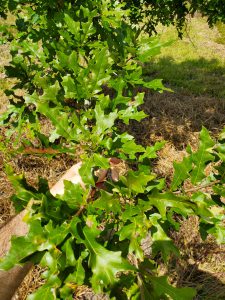
Overcup Oak leaves in August. Note the characteristic “lyre” shape. Photo courtesy Daniel Leonard.
Overcup Oak is also an exceedingly attractive tree. In youth, the species is extremely uniform, with a straight, stout trunk and rounded “lollipop” canopy. This regular habit is maintained into adulthood, where it becomes a stately tree with a distinctly upturned branching habit, lending itself well to mowers and other traffic underneath without having to worry about hitting low-hanging branches. The large, lustrous green leaves are lyre-shaped if you use your imagination (hence the name, Quercus lyrata) and turn a not-unattractive yellowish brown in fall. Overcups especially shine in the winter when the whitish gray shaggy bark takes center stage. The bark is very reminiscent of White Oak or Shagbark Hickory and is exceedingly pretty relative to other landscape trees that can be successfully grown here.
Finally, Overcup Oak is among the easiest to grow landscape trees. We have already discussed its ability to tolerate wet soils and our blazing heat and humidity, but Overcups can also tolerate periodic drought, partial shade, and nearly any soil pH. They are long-lived trees and have no known serious pest or disease problems. They transplant easily from standard nursery containers or dug from a field (if it’s a larger specimen), making establishment in the landscape an easy task. In the establishment phase, defined as the first year or two after transplanting, young transplanted Overcups require only a weekly rain or irrigation event of around 1” (wetter areas may not require any supplemental irrigation) and bi-annual applications of a general purpose fertilizer, 10-10-10 or similar. After that, they are generally on their own without any help!
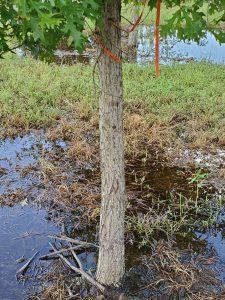
Typical shaggy bark on 7 year old Overcup Oak. Photo courtesy Daniel Leonard.
If you’ve been looking for an attractive, low-maintenance tree for a pond bank or just generally wet area in your lawn or property, Overcup Oak might be your answer. For more information on Overcup Oak, other landscape trees and native plants, give your local UF/IFAS County Extension office a call!
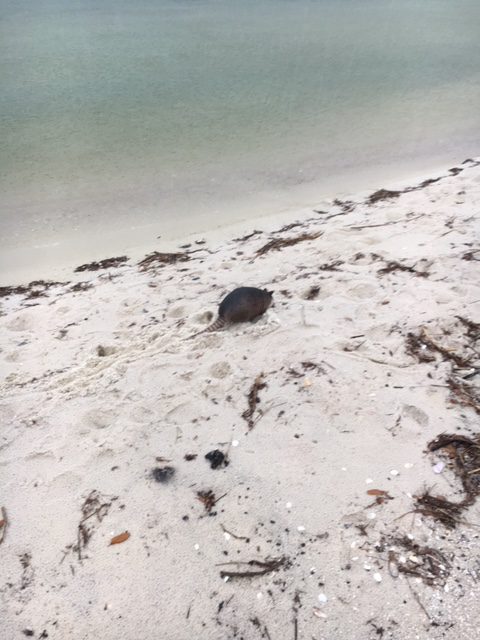
by Rick O'Connor | Aug 21, 2020
You are probably not going to see them… but they are there.
Mammals are fur covered warm blooded creatures. Beaches are hot, dry, sandy places. Just as in the deserts, it would make sense for island mammals to be nocturnal. We know of their existence by their tracks and their scat. Rabbit, raccoon, and armadillo tracks are quite common. Deer, coyote, and beach mice less so. All that said, some are seen at dawn and dusk and it is not unheard of to see them in the middle of the day – especially during the cooler months.
One question that may come up is – “how did they get to an isolated island?” Some scientists have a lot of fun trying to solve that mystery. Some island mammals, like otters, are very good swimmers and would have no problem. Many barrier islands begin as sand spits connected to the mainland – the mammals ventured out into new territory – set up camp – and either over time, or over night in a hurricane – the spit breaks off and the mammals are there. And let’s not forget we built bridges – they know how to use them. Coyotes have been seen walking across the Bob Sikes Bridge from Gulf Breeze.
Another question that comes up – “where are they in the middle of the day?” Most dig, or find, burrows and dens. Just a few inches below the surface it is very cool. Some will find thick hammocks in the maritime forest and “hunker down” for the day.
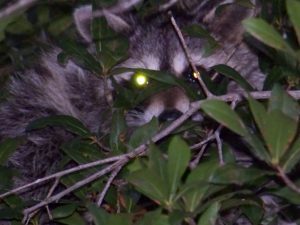
The sneaky raccoon is an intelligent creature and has learned to live with humans.
Photo: Molly O’Connor
Raccoons
The raccoon (Procyon lotor) is one of the more intelligent and fearless of the beach mammals. Their opportunistic behavior frequently brings them into contact with humans. They will scurry across your lawn at night looking for insects, cat food, garbage, whatever they can find to eat – and outdoor lights do not seem to bother them. There are even videos of them reaching into “dog doors” searching. On the island, their tracks are often found in the marsh areas – where they grab shellfish and are one of the few animals that wash their food before eating it. They usually like to settle into hollow trees during the day. But on the island, it is more likely burrows in the sand.
Their tracks might show the presence of a claw (always hard in soft sand – better chance in wet). The front foot is smaller than the back and they walk with an alternating pattern – usually the front and back foot are close to each other – unless they are running. The front foot is about 2.5”x2.5” – a little round, and the index from the pad to the tip is thinner. The hind foot is about 2.5” wide but closer to 4” long.
The scat is cigar shaped and about 3” long.
Read more:
https://myfwc.com/media/1666/livingwithraccoons.pdf.
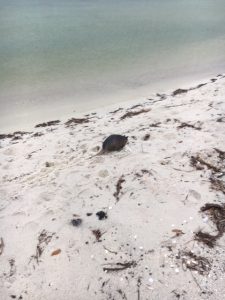
The bizarre looking armadillo enjoys a walk on the beach.
Photo: Rick O’Connor
Armadillo
Here is an interesting creature. It doesn’t even look like a mammal – not sure what it looks like. But mammals they are. If you find one that has been hit by a car you can see, amongst the armored plating, hairs spaced across the body – they are mammals. It is one that is sometimes seen roaming in the middle of the day. They plunge through the leaf litter and bushes of the maritime forest, making a lot of noise, while searching for insects and grubs and crushing them with their peg-like teeth. They are not from around here – rather from central America – and worked their way into the American southwest and southeast. They probably reached the island via the bridges. They are prolific produces – usually having quadruplets of the same sex. You once found them occasionally in the national seashore – but since Hurricane Ivan, you can find them almost anywhere. One bothersome fact of this animal – they are known to carry leprosy – which can be contacted by eating the animal, or handling it.
Their tracks are one of the most common on the beach. The front foot is about 1.8” long and 1.4” wide. You will see only four toes and claw marks may be seen. The two middle toes are longer. The hind foot has a similar pattern, but you will see five toes and they are about 2.2” long. Most tracks include the tail drag between the foot marks. These are quite common all over the island.
The scat is round-ish and not very long – about 2”.
Read more:
https://edis.ifas.ufl.edu/pdffiles/UW/UW45600.pdf
https://myfwc.com/wildlifehabitats/profiles/mammals/land/armadillo/
https://www.floridamuseum.ufl.edu/science/five-facts-nine-banded-armadillo/.
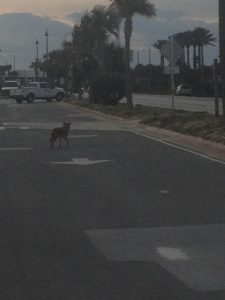
A coyote moving on Pensacola Beach near dawn.
Photo provided by Shelley Johnson.
Coyote
This is an animal that makes people nervous. They are one of the larger mammals on the beach, and they are carnivores. Attacks on pets and children are a concern for many. However, this is rarely the case. Studies show that they are actually very nervous around people and tend to stay at a distance. However, if fed cat food or available garbage, they will lose that fear and problems can occur. Like most island mammals, they are nocturnal, and diet studies have found the bulk of their meals are rodents – which is doing us a favor. But, like raccoons, they are intelligent and opportunistic. If they find an easy meal, like shorebird and turtle eggs – or the chicks and hatchlings – they will take them. It was once thought they were creatures of the American west and migrated into the eastern United States. Some scientists have found coyote remains in the eastern US that predate the ice age – so maybe they are just returning home. There are also reports of humans bringing them here for “fox hunts” – not realizing these were not fox. Either way, they are in all 67 counties of Florida, and on Pensacola Beach. They look similar to dogs – but will be thinner and their tails hang down between their legs when they run. One way to know if they are around is to listen when a siren is going – they tend to howl at these.
Their tracks are very similar to dogs and more people are bringing dogs onto the beach and into natural areas – hard to tell them apart. The pad at the rear of both the front and back paws of the coyote has three lobes, dogs have two on the front foot. In general, dog tracks are more round, coyotes typically are long and not as wide. Characteristic of dog family – the claw marks can be seen. Keep in mind that tracks are distorted in soft sand – best to look in wet sand.
The scat is also characteristic of wild canines – long and thin (like a hot dog) and tapered at each end (like a tamale). Coyote scat is usually 3-8” long and may have the characteristic claw scratching marks some dogs do.
Read more:
https://edis.ifas.ufl.edu/pdffiles/UW/UW44300.pdf.
https://myfwc.com/conservation/you-conserve/wildlife/coyotes/.
https://myfwc.com/wildlifehabitats/profiles/mammals/land/coyote/
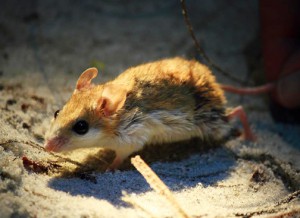
The Choctawhatchee Beach Mouse is one of four Florida Panhandle Species classified as endangered or threatened. Beach mice provide important ecological roles promoting the health of our coastal dunes and beaches. Photo provided by Jeff Tabbert
Beach Mouse
Beach mice are like the Loch Ness monster – everyone talks about them, but no one has seen one. Many locals have lived on this beach all of their lives and have never seen one – but they are there – and they are protected. The deal with protection is that these are isolated populations on each island. With no chance to mix genes, they have become “unique” and found no where else. There are four species in the state listed as endangered – including the nearby Perdido Key Beach Mouse and the Choctawhatchee Beach Mouse. It is believed the subspecies found on Pensacola Beach is the Santa Rosa Beach Mouse and is not listed as endangered – but is a species of concern (see list in link below). These little guys dig multiple burrows throughout the dune field but prefer those that are more open and have plenty of sea oats. They emerge at night feeding on a variety of seeds, fruits, and even insects – but sea oats are their favorite. It has been suggested they play an important role of dispersing these seeds. The introduction of new predators, and human development, have put these guys at high risk of extinction.
As you can imagine, the tracks are tiny. They are round in shape and show claw marks.
Read more:
https://edis.ifas.ufl.edu/pdffiles/UW/UW17300.pdf.
https://myfwc.com/media/1945/threatend-endangered-species.pdf.
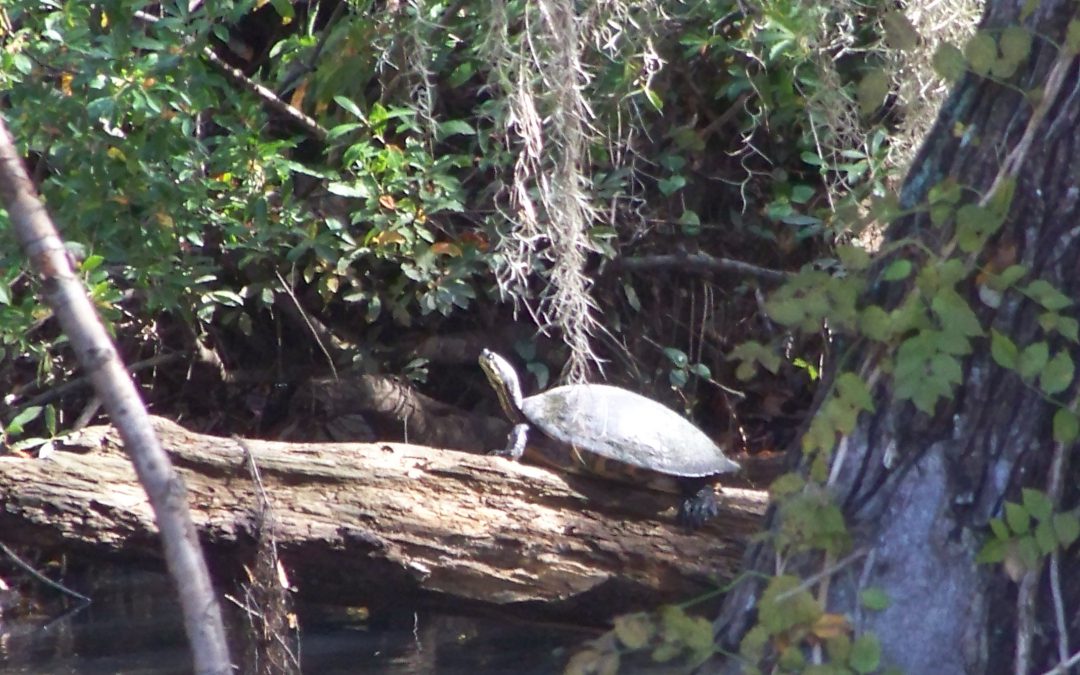
by Rick O'Connor | Jul 2, 2020
Cooters are one of the more commonly seen turtles when visiting a freshwater system. They are relatively large for a freshwater turtle (with a carapace about 13 inches long) and are often seen basking on logs, rocks, aerator pumps, you name it – and often in high numbers while doing so. They spook easy and usually leap into the water long before you reach them. But because of their beautiful smooth shells and large size, they can be seen from a distance – looking like wet rocks on a tree limb.
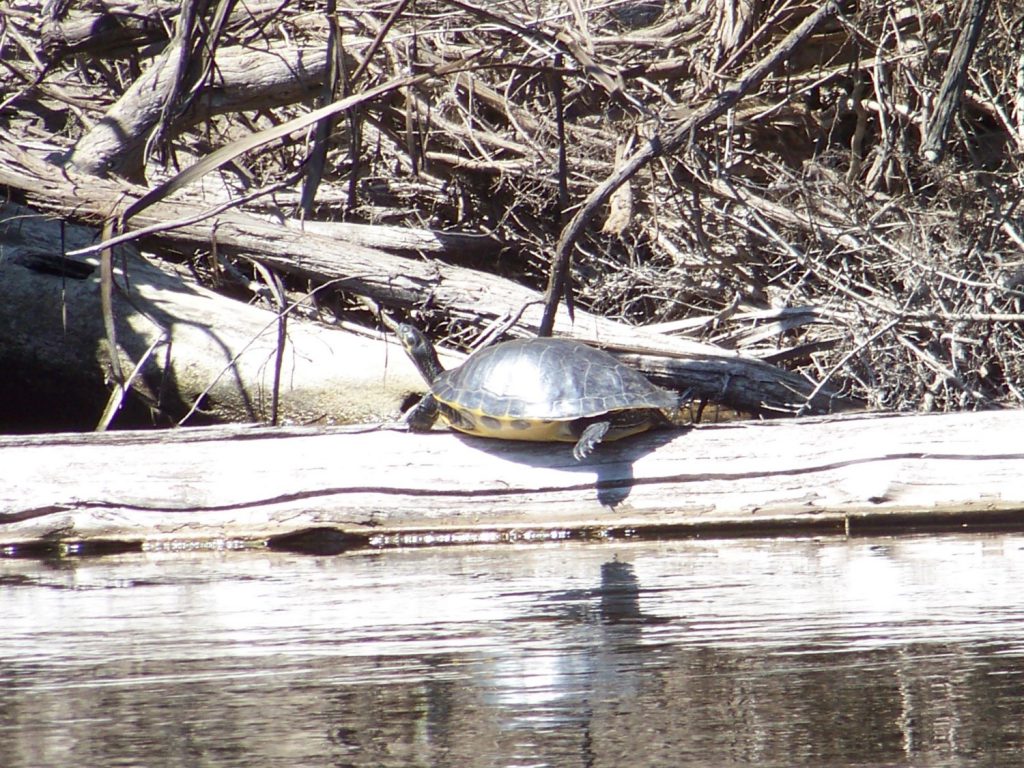
A “River Cooter” seen basking on a log in Blackwater River.
Photo: Molly O’Connor
They are in the genus Pseudemys (same as the Florida red-bellied turtles) and this genus is found throughout the southeastern United States. However, from there the breakdown of species becomes a bit challenging. There has been much debate how many species there really area, and how many are subspecies of those species. There are two distinct species for sure – the “River Cooter” (Pseudemys concinna) and the “Pond Cooter” (Pseudemys floridana). From here is gets a bit weird.
The “River Cooters” are just that – friends of rivers. They like those with a bit of a current, sand/gravel bottoms, basking spots, and grasses to eat. They have been found in estuaries, even with barnacles growing on them, so they have some tolerance for saltwater. River cooters can be distinguished from their “Pond Cooter” cousins in having a more aerodynamic shell (presumably for their habit of living in faster flowing rivers) with yellow-orange markings that form concentric rings on each scute (scale) of the carapace. Some of these seem to form a backwards “C”. Their plastron is yellow-orange but will have black markings along the margins of each scute.
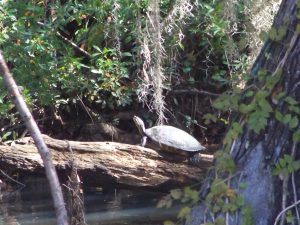
This river cooter is basking on a log on the heads waters of the Choctawhatchee River in Alabama.
Photo: Molly O’Connor
The “Suwannee Cooter” is believed to be a subspecies (Pseudemys concinna suwanniensis) found in tannic rivers from the Ochlockonee just west of Tallahassee south to the Tampa Bay region. It has only been found in rivers that flow into the Gulf of Mexico. A couple of records have been found in rivers flowing towards the Atlantic, but it is believed these were relocated by humans.
The “Eastern River Cooter” is found from the Ochlockonee River west to Mobile Bay – possibly as far as Louisiana. There has been a suggestion that the one west of Mobile Bay is the “Mobile Cooter” (Pseudemys concinna mobilensis) but the naming of this group, again, has been a bit crazy.
As mentioned, “Pond Cooters” are fans of slow-moving waters with muddy bottoms. Unlike river cooters, pond cooters will travel over land other than to lay eggs. Many of their “pond” selections dry up and they must find new habitat. Like river cooters, pond cooters feed on vegetation so aquatic plants are must and they also like to bask in the sun on logs with many cooters basking at once.
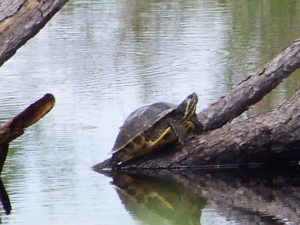
A pond cooter in a canal within the Gulf Islands National Seashore.
Photo: Molly O’Connor
Physically they differ from river cooters in having a slightly domed shell near the head end. The yellow markings are not concentric, but rather are in straight lines and their plastrons are an immaculate beautiful yellow – with no markings on the margins. They do however have black circles on the bottom margins of their carapace. These are usually round with a small yellow spot in the center – resembling an “o”.
There is believed to be two subspecies of this group. Pseudemys floridana floridiana (the “Florida Cooter”) and Pseudemys floridana peninuslaris (the “Peninsula Cooter”). Told you it was all weird. The Florida cooter is found in the Florida panhandle and the Peninsula Cooter has been found all the way to the Florida Keys – though it does not seem to be common in the Everglades.
Add to the quagmire of species identification – there is hybridization between not only the types of pond and river cooters – but BETWEEN the pond and river cooters. So, if you live in the eastern panhandle where all of these seem to converge – just call them “cooters”!
They have an interesting nesting habit. When the females approach an open sunny sandy spot, she will dig a hole to lay about 20 eggs, but she will also dig two “satellite” nests on either side – and maybe place an egg or two in there. It is quite understood why they do this, but they do. They also may come to the beach up to five times in one year to lay eggs.
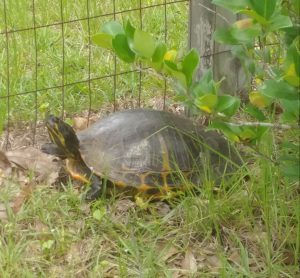
A pond cooter digging a nest on someone’s property.
Photo: Deb Mozert
Because of their high numbers and large size, this has been a favorite food item for humans for quite some time. Due to this, and the practice of shooting them off their basking spots, and alterations of river systems lower the habitat quality for the river cooters, their numbers have declined. The Suwannee Cooter in particular has been hard hit and is a species of concern. Due to this it no longer allowed to harvest them (or their eggs) from the wild. Because it is so hard to tell the Suwannee from other species/subspecies of cooters – ALL cooters are now protected by the Florida Fish and Wildlife Conservation Commission.
Another note – they do not eat fish. The young will eat worms and insects, but the adults are strictly herbivores. Many pond owners want to shoot them thinking they are eating the stocked fish by the landowner. They will not eat the fish – you are fine.
I think these are amazingly beautiful animals to see glimmering in the sunny on their basking logs as you explore our local rivers and wetlands. I hope you find them just as cool and appreciate them.
Resources:
Buhlman, K., T. Tuberville, W. Gibbons. 2008. Turtles of the Southeast. University of Georgia Press, Athens GA. 252 pp.
Florida Fish and Wildlife Conservation Commission. Freshwater Turtles https://myfwc.com/wildlifehabitats/wildlife/freshwater-turtles/.
Meylan, P.A. (Ed.). 2006. Biology and Conservation of Florida Turtles. Chelonian Research Monographs No.3, 376 pp.
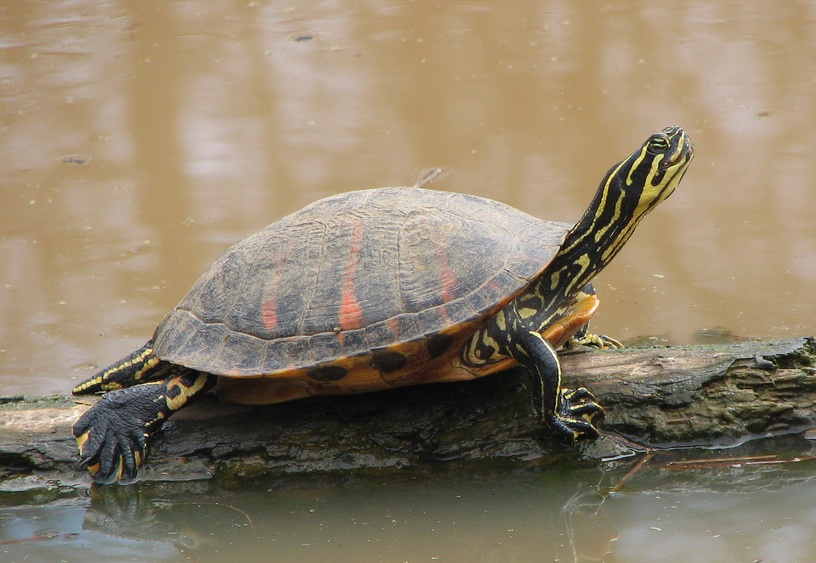
by Rick O'Connor | Jun 18, 2020
Cooters are common freshwater turtles throughout the state of Florida. There are currently three species listed: Pseudemys concinna – commonly known as the “river cooter”, Pseudemys floridana – referred to as the “Florida cooter”, and Pseudemys nelsoni – the “Florida red-bellied turtle”. It is this third species we will focus on in this article.
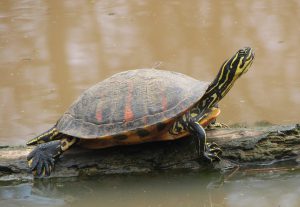
The wide red markings contrasting with the yellow striping on the body makes this a beautiful turtle.
Photo: Wikipedia
When you pick up a Florida red-bellied turtle you will see why it gets that name. The belly, or plastron, is a reddish-orange color. You will also see red coloration of the large broad stripes on the carapace and small red spots on the marginal scutes of the carapace. Contrasting this with the brilliant yellow stripes of the head and legs – this a beautiful turtle.
Like other cooters, they are big pond turtles as well – reaching carapace lengths up to 15 inches. They have high domed shells, compared to the other two cooters, and the shell is much thicker. This is probably due to the fact that the Florida red-bellied lives with the American alligator. They are known to even lay their eggs in an alligator nest! Other features that separate them from their cousins is the presence of yellow striping between the eyes resembling an “arrow”, and a deep notch in the upper lip.
The distribution of this turtle is interesting. They are definitely found, and are common, in the peninsular part of the state – ranging from the Okefenokee Swamp in southern Georgia to the Florida Everglades. Here they most frequently found in slow moving backwaters of rivers and springs, lakes, ponds, marshes, sinkholes, and even canals along highways. However, there have been verified reports of this animal in the Apalachicola River basin. Several have been found on St. Vincent island between Apalachicola and Port St. Joe. One was photographed within the city limits of Apalachicola and a few in the Dead Lake region of the Chipola River feeding into the Apalachicola. There is about 100 miles between the Suwannee and Apalachicola River systems – how did they make this trip?

The red coloration of the common Florida Red-bellied turtle.
Photo: Flickr
One idea is that someone brought them there a long time ago – and they have survived. A long time meaning prior to the 1950s. Another thought is that the historic range may have included much of the Florida panhandle before sea level changed. There is an Alabama Red-bellied turtle (Pseudemys alabamensis) that inhabits the marshes of the Mobile Bay delta. The habitat here is very similar to the marshes of the Everglades, and the Apalachicola region. The Alabama red-bellied has very similar characteristics to the Florida red-bellied (arrow stripes and notch in upper lip). There are no records of the Alabama Red-bellied in the delta of the Escambia River, and no record of either species in the Choctawhatchee delta. So, who knows??? To add to the story – one Florida Red-bellied was verified in the Wacissa River – which lies about halfway between the Suwannee and the Apalachicola rivers. Yep… interesting mystery.
Like other cooters, the females are larger than the males and the males have elongated fingernails on their forelimbs to entice the female’s interest in mating. These long fingernails are also found on the sliders (Trachemys). In Florida, the red-bellied appears to breed year-round. Even though nesting is typical of other turtles (spring and summer) they may lay eggs year-round as well.
The females will approach the beach multiple times during the nesting season and lay anywhere from 6-30 eggs in the nest. Sex determination of the young is determined by the temperature within the nest, warmer eggs become females. The Florida red-bellied has an unusual habit of laying some of their eggs in alligator nests. Though alligators can be considered a predator of this turtle, sneaking in and laying eggs will provide protection – for unlike turtles, alligators guard their nests from predators. It is believed the thicker shell of the Florida red-bellied is to protect it from this possible adversary.
That said, they do have their predators. Like all young turtles there are a variety of birds, fish, mammals, and reptiles that feed on them. Red-bellies are plant eaters – feeding on a variety of aquatic plants including the invasive water hyacinth and hydrilla.
These are common basking turtles throughout much of peninsular Florida and visitors should easily get a glimpse of them while they are here. How far into the Florida panhandle they range is still a mystery – but an interesting one. I hope one day you get to see this beautiful turtle.
References
Buhlmann, K., T. Tuberville, W. Gibbons. 2008. Turtles of the Southeast. University of Georgia press, Athens GA. 251 pp.
Meylan, P.A. (Ed.) 2006. Biology and Conservation of Florida Turtles. Chelonian Research Monographs No.3. 376pp.
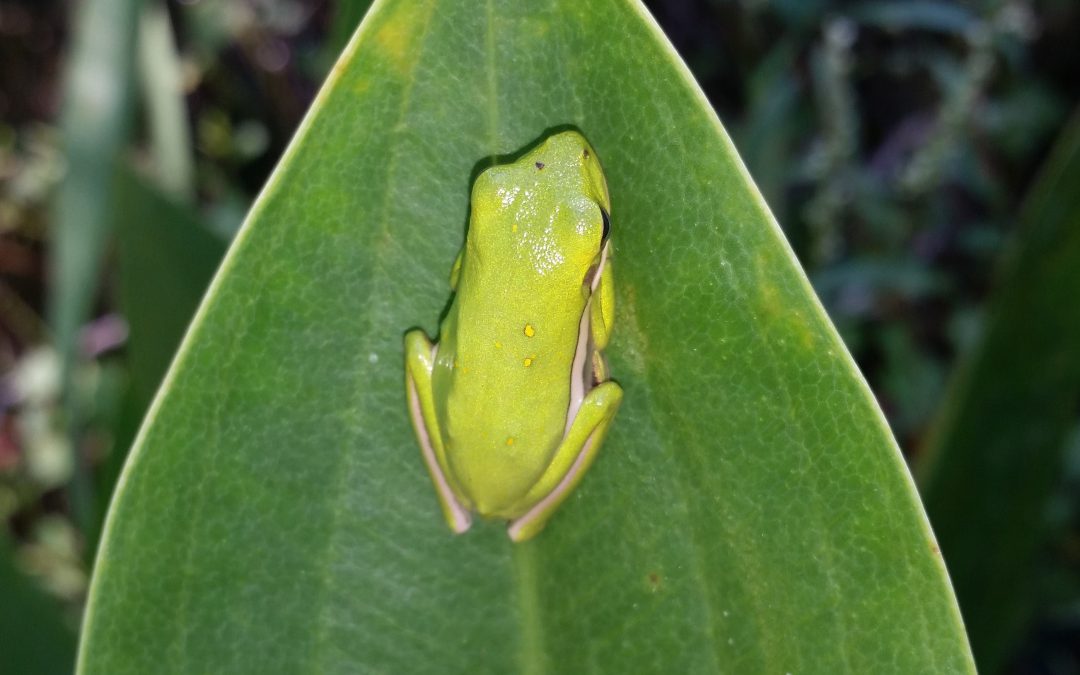
by Erik Lovestrand | Jun 4, 2020
WOW… is all I can say, when I step outside at night of late and become immersed in the spectacular chorus of calls from breeding frogs and toads near my Wakulla County residence. The sound reverberates to the level where it sometimes feels like it is echoing inside one’s head. Recent heavy rains have awakened local species to the notion that there is no time like the present for pro-creation; given the fact that many of the shallow, depressional wetlands in our region will only contain water for a short window of time.
This may seem like a drawback to the life style of frogs and toads that depend on these wetlands but nature has a way of surprising us with incredible adaptations for survival. For instance, the eastern spadefoot toad (Scaphiopus holbrookii) can actually survive through several years with no water available for raising their young. They do this by remaining buried in the ground, only emerging after heavy rains that collect in depressions. Tadpoles metamorphose into small toads within 28 days so by the time the pool goes dry they are likely long-gone. Female spadefoots will lay over 2,000 eggs at a time so the number of progeny that can emerge from a small depressional wetland is phenomenal. I recall seeing black stains across roadways all over the County about a month after one of our tropical storms. Baby spadefoot toads were dispersing by the millions from hundreds of shallow pools across the region and local roadways were one of the hazards they faced on their journey.
Another advantage to amphibians breeding in ephemeral (temporary) wetlands has to do with the fact that there are no fish to prey on the tadpoles. This is not a requirement for all species, as some have chemical defenses (bad taste) that limit predation, but others could not successfully breed in permanent bodies of water.
Some of the species I have heard calling lately include squirrel treefrogs, green treefrogs, Cope’s gray treefrogs, southern toads, cricket frogs, and a few others I have not identified yet. If you have never made an effort to identify the night calls of frogs and toads, you don’t know what you are missing in your local environment. Some are quite difficult to separate but many of very distinct and once you put the call with a name you won’t ever forget it. Take a moment to listen to one of my favorites, the southern toad; the origin of a beautiful, high-pitched trill that you most likely have never paid much attention to. This website (The Frog Blog) is a great resource to learn more calls. Be sure to listen also to the southern cricket frog call that sounds like two marbles clacked together, and Copes’ gray treefrog, which many might mistake for a bird as they call from high in the tree canopy.
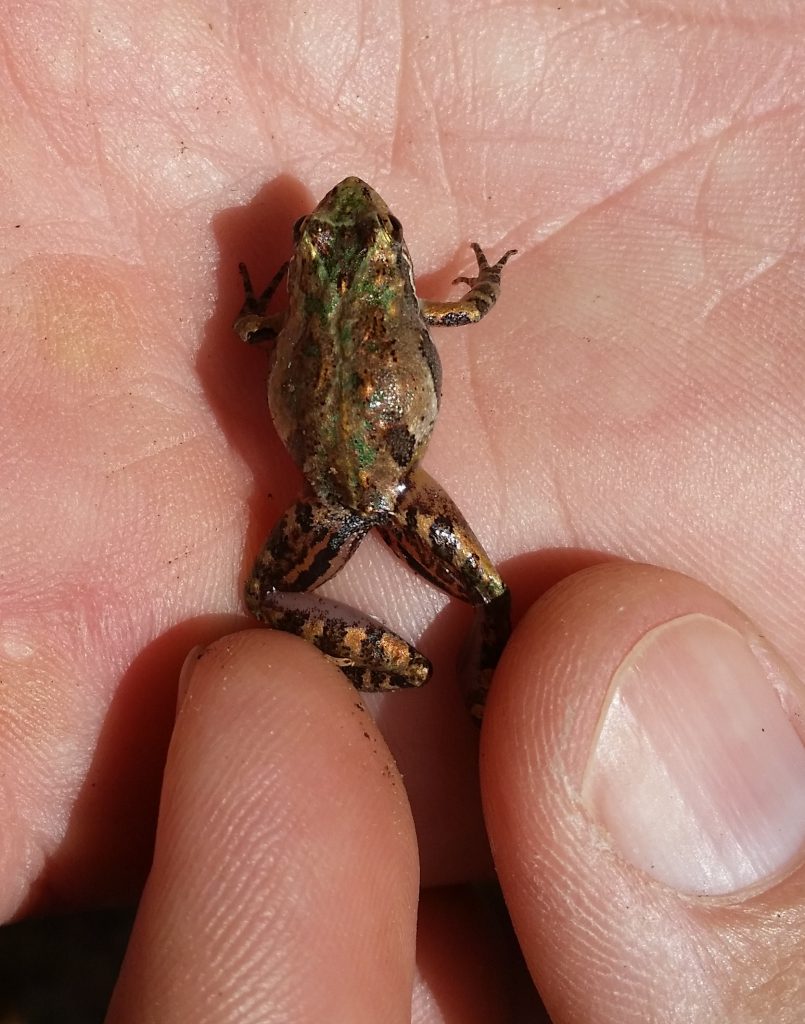
Cricket frogs are one of the smallest vertebrates on the planet.
The cacophony of sounds on a warm summer’s night can seem chaotic and random but if you spend a little time sorting out the musicians, you are sure to develop a deeper appreciation of the symphony, along with a better understanding of the well-orchestrated cycles of nature in your Panhandle backyard.
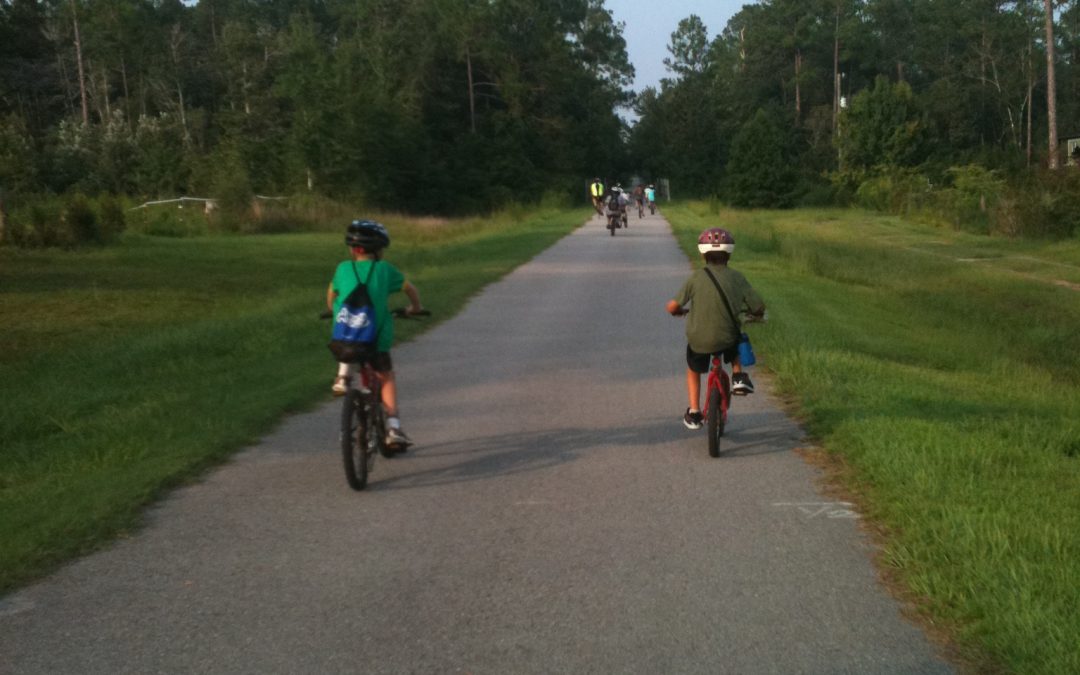
by Carrie Stevenson | May 29, 2020
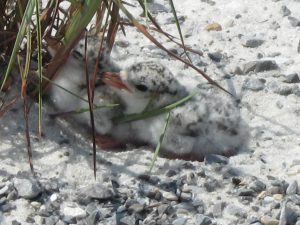
Baby terns on Pensacola Beach are camouflaged in plain sight on the sand. This coloration protects them from predators but can also make them vulnerable to people walking through nesting areas. Photo credit: UF IFAS Extension
The controversial incident recently in New York between a birdwatcher and a dog owner got me thinking about outdoor ethics. Most of us are familiar with the “leave no trace” principles of “taking only photographs and leaving only footprints.” This concept is vital to keeping our natural places beautiful, clean, and safe. However, there are several other matters of ethics and courtesy one should consider when spending time outdoors.
- On our Gulf beaches in the summer, sea turtles and shorebirds are nesting. The presence of this type of wildlife is an integral part of why people want to visit our shores—to see animals they can’t see at home, and to know there’s a place in the world where this natural beauty exists. Bird and turtle eggs are fragile, and the newly hatched young are extremely vulnerable. Signage is up all over, so please observe speed limits, avoid marked nesting areas, and don’t feed or chase birds. Flying away from a perceived predator expends unnecessary energy that birds need to care for young, find food, and avoid other threats.
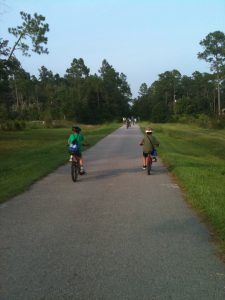
When on a multi-use trail, it is important to use common courtesy to prevent accidents. Photo credit: Carrie Stevenson, UF IFAS Extension
- On a trail, the rules of thumb are these: hikers yield to equestrians, cyclists yield to all other users, and anyone on a trail should announce themselves when passing another person from behind.
- Obey leash laws, and keep your leash short when approaching someone else to prevent unwanted encounters between pets, wildlife, or other people. Keep in mind that some dogs frighten easily and respond aggressively regardless of how well-trained your dog is. In addition, young children or adults with physical limitations can be knocked down by an overly friendly pet.
- Keep plenty of space between your group and others when visiting parks and beaches. This not only abides by current health recommendations, but also allows for privacy, quiet, and avoidance of physically disturbing others with a stray ball or Frisbee.
Summer is beautiful in northwest Florida, and we welcome visitors from all over the world. Common courtesy will help make everyone’s experience enjoyable.























